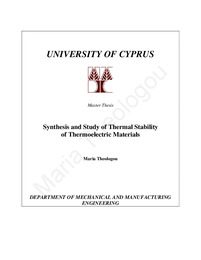| dc.contributor.advisor | Kyratsi, Theodora | en |
| dc.contributor.author | Theologou, Maria C. | en |
| dc.coverage.spatial | Cyprus | en |
| dc.creator | Theologou, Maria C. | en |
| dc.date.accessioned | 2022-02-16T09:51:49Z | |
| dc.date.available | 2022-02-16T09:51:49Z | |
| dc.date.issued | 2021-06-01 | |
| dc.identifier.uri | http://gnosis.library.ucy.ac.cy/handle/7/65072 | en |
| dc.description.abstract | In the last decades, an enormous interest appears at the scientific community on the magnesium silicide type materials that exhibit remarkable thermoelectric properties. Environmental-friendliness, low cost, excellent thermoelectric properties, abundance of the elements, high reliability, and non-toxicity are the main reasons that magnesium silicides are considered for future use on high temperature power generation applications.
Furthermore, consumption of energy has become one of the most important issues worldwide. In addition to improving alternative energy sources, saving energy is also critical in order to satisfy the rapidly increasing demand. Additionally, transportation is considered one of the largest consumptions of energy. Evidently, three quarters of the energy used for transportation is wasted as heat released to the environment. Thermoelectric generators can offer an alternative solution since they can convert wasted heat to electricity. Since these applications are mainly working in medium temperature range, stability issues are extremely important for the lifetime of such devices.
The main purpose of this thesis was to study the thermal stability of highly efficient Mg2Si0.57Sn0.4Bi0.03 thermoelectric material. Mg2Si0.57Sn0.4Bi0.03 was synthesized by mechanical alloying and consolidated by hot press sintering. Thermal stability of the synthesized materials was tested by applying three different coatings on the samples, exposed at the same temperature conditions in two different atmospheres (air and argon). The coatings used were Bison, Soudal and Boron Nitride spray. The results showed that argon annealed samples were less affected from the heat treatment, compared to air annealed samples. Bison and Soudal coatings could not protect the synthesized material from oxidation and Mg loss during heat treatment. On the other hand, argon annealed samples with BN as well as without coating were less affected from the specific procedure. Finally, applying boron nitride coating seems an effective way to minimize oxidation and Mg loss from heat treatment procedure. | en |
| dc.language.iso | eng | en |
| dc.publisher | Πανεπιστήμιο Κύπρου, Πολυτεχνική Σχολή / University of Cyprus, Faculty of Engineering | |
| dc.rights | info:eu-repo/semantics/openAccess | en |
| dc.rights | Open Access | en |
| dc.title | Synthesis and study of thermal stability of thermoelectric materials | en |
| dc.type | info:eu-repo/semantics/masterThesis | en |
| dc.contributor.committeemember | Giapintzakis, Ioannis | en |
| dc.contributor.committeemember | Krasia-Christoforou, Theodora | en |
| dc.contributor.department | Τμήμα Μηχανικών Μηχανολογίας και Κατασκευαστικής / Department of Mechanical and Manufacturing Engineering | |
| dc.subject.uncontrolledterm | THERMAL STABILITY | en |
| dc.subject.uncontrolledterm | THERMOELECTRIC MATERIALS | en |
| dc.subject.uncontrolledterm | SYNTHESIS OF THERMOELECTRIC MATERIALS | en |
| dc.author.faculty | Πολυτεχνική Σχολή / Faculty of Engineering | |
| dc.author.department | Τμήμα Μηχανικών Μηχανολογίας και Κατασκευαστικής / Department of Mechanical and Manufacturing Engineering | |
| dc.type.uhtype | Master Thesis | en |
| dc.contributor.orcid | Kyratsi, Theodora [0000-0003-2916-1708] | |
| dc.gnosis.orcid | 0000-0003-2916-1708 | |

